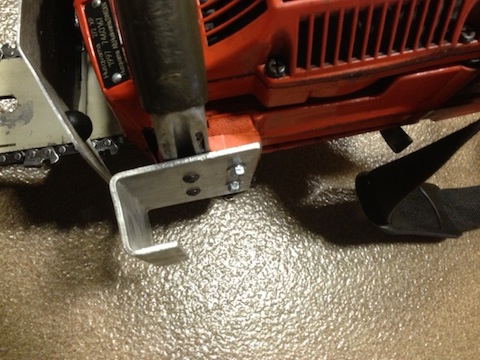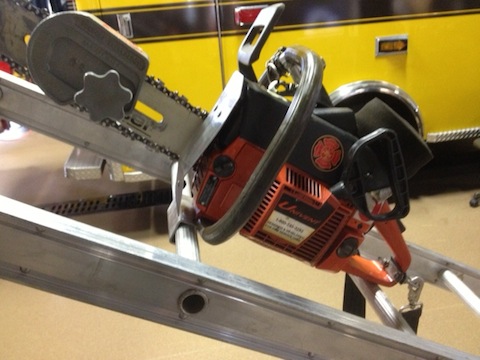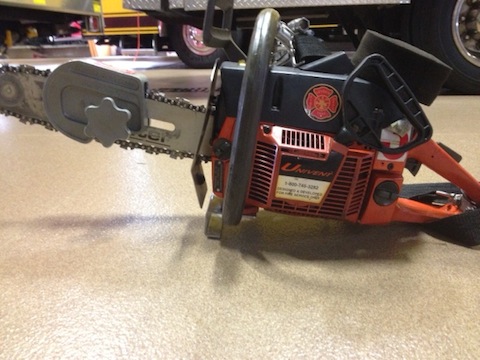Lieutenant Kevin Nay from Leyden (IL) Fire Protection District sent in this easy saw modification. They were looking for a simple way to secure the chainsaw when not in use while operating on a peaked roof. They fabricated a bracket from scrap plate aluminum found in the shop. The bracket simply uses the existing screw holes for attaching the bracket to the saw. The cost was under $2 for the longer screws.


This technique is useful for chainsaws that have the depth guard on the bar. Making this modification changes how the saw “sits†(as seen below) but will not change how the saw “feels.†Either way everyone should get hands on and train with the saw after this (or any) modification to become familiar with it.


Now to get rid of that #@$#%@$#%$ depth guard.
Depth guards are for engine guys who like the play truckies on the weekend.
That’s a really cool idea! Wanted to share that we recently developed an “armor plate” for chainsaws, especially for ventilation saws. Check out http://www.sawarmor.com, Kentland 33 in Maryland is ip using one of our Dolmar units kitted out with the Saw Armor plate. I am looking into developing a mounting/fastening bracket to add to my plate also. Let me know if any questions or if I can help? Tom
Nice idea Lt.
Shouldn’t be cutting peaked roofs to start with!
Why would you not vent a peaked roof other than fear? How does the shape of the roof dictate whether or not the fire compartment needs venting. Heat still travels up if the roof is flat or peaked. You don’t vent attic fires? The predominant building we deal with is a cape cod style house and the knee walls often need venting. Just becuse FDNY doesn’t vent peaked roofs doesn’t make it the only or even the right way. Plenty of Chicago, Milwaukee, and other midwestern firemen would disagree with you. If you are only comfortable on flat roofs then I guess that is your Engine company’s problem. This site used to be about guys sharing knowledge and trying to make the job better, but I see it’s turned into one line snipers worthy of firehouse.com forums. Let the feeding frenzy of salty internet know-it-alls begin.
Wow You guys have really PEAKED my attention.
Note that this slightly peaked roof is a training setup. Good traction on the asphalt shingles. Walked up it no problems…looking for fire companies to try out the new Saw Armor plate. Any takers? Tom@sawarmor.com
In the first picture it looks like there is 2 screws and 2 bolts. Is this the case?
@SouthernFire We have reached out to Kevin Nay via email for clarification on mounting this bracket. As soon as we get a response we will pass it along as well as update the post. Thank you for your question.
Eric
There are 4 screws holding the bracket on. The front 2 are machine screws which go into cut threads on this particular saw, and the rear two that look like bolts are actually a self tapping type screw that cuts its own threads into the plastic housing. The hex head was the only type screw that matched the threads on the original thread cutting screws that we could find at our local hardware store.
I have to agree with K Nay. If there is a need for venting, it shouldn’t matter if there is a peaked roof or not. To piggy back off of what K Nay said, there are many departments that ventilate peaked roofs, and some that ventilate peaked roofs routinely (i.e. many California departments). If the peak of the roof is too steep and is of concern, the Milwaukee cut is always a viable option. I think it’s too bad that people are ruling vertical ventilation out just because a roof is a certain configuration.
Also, I would like to comment on the depth guard. While I think that it’s not in good practice for one fireman to bash another for using a depth guard. I think it is important to explain why it is not a beneficial element to have when performing vertical ventilation. An experienced fireman in Vertical Ventilation would probably tell you that when they cut into a roof, they keep their saw vertical, plunge in, move the saw until they hit a truss, pull the saw out, and then plunge in again (all the while remaining vertical). The reason for this is because when the saw is vertical, there is more surface area that encounters a truss when you hit it. Therefore, there is more noticeable kick-back and resistance, making it easier to gauge where the trusses are and when to pull out. A depth guard encourages horizontal operation of the saw, and an diminished ability to detect trusses. You should see our vertical vent prop after using a guard, it looks like someone intentionally just ran their saw through the trusses.
this is dumb. idiot.